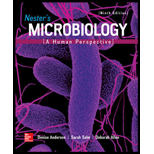
Describe how the skin protects against infection.
To review:
The way skin protects the body against the infection.
Introduction:
Skin is basically the external soft layer of tissue present on the vertebrates. Many animals have an anthropoid exoskeleton, which comes from the different developmental origin and has different chemical and structure composition. Skin is considered to be the part of the integumentary system of the mammals and comprises many different layers.
Explanation of Solution
The skin is considered to be the first line of defense and for an infection to occur, many pathogens enter the body and spread the infection. As they enter, the host body provides conditions, which are ideal for living, such as plenty of water, food, and warmth. However, to destroy their production, the immune system comes their way. The body’s defense system fights against such infections and pathogens that are basically body’s coordinated response in invading the pathogens. The first line of defense includes skin, tears, sweat, and acid present in the stomach.
The entire body is covered with skin with an aim of protecting the body from the physical damage, dehydration, and microbe infection. The skin works as a barrier and does not allow the microbes to penetrate the skin and enter the body. Moreover, sebaceous glands are situated inside the skin, which releases oils and this oils aid in killing the microbes.
Therefore, it can be concluded that the skin is considered to be the first line of defense.
Want to see more full solutions like this?
Chapter 14 Solutions
Nester's Microbiology: A Human Perspective
- In one paragraph show how atoms and they're structure are related to the structure of dna and proteins. Talk about what atoms are. what they're made of, why chemical bonding is important to DNA?arrow_forwardWhat are the structure and properties of atoms and chemical bonds (especially how they relate to DNA and proteins).arrow_forwardThe Sentinel Cell: Nature’s Answer to Cancer?arrow_forward
- Molecular Biology Question You are working to characterize a novel protein in mice. Analysis shows that high levels of the primary transcript that codes for this protein are found in tissue from the brain, muscle, liver, and pancreas. However, an antibody that recognizes the C-terminal portion of the protein indicates that the protein is present in brain, muscle, and liver, but not in the pancreas. What is the most likely explanation for this result?arrow_forwardMolecular Biology Explain/discuss how “slow stop” and “quick/fast stop” mutants wereused to identify different protein involved in DNA replication in E. coli.arrow_forwardMolecular Biology Question A gene that codes for a protein was removed from a eukaryotic cell and inserted into a prokaryotic cell. Although the gene was successfully transcribed and translated, it produced a different protein than it produced in the eukaryotic cell. What is the most likely explanation?arrow_forward
- Molecular Biology LIST three characteristics of origins of replicationarrow_forwardMolecular Biology Question Please help. Thank you For E coli DNA polymerase III, give the structure and function of the b-clamp sub-complex. Describe how the structure of this sub-complex is important for it’s function.arrow_forwardMolecular Biology LIST three characteristics of DNA Polymerasesarrow_forward
 Human Physiology: From Cells to Systems (MindTap ...BiologyISBN:9781285866932Author:Lauralee SherwoodPublisher:Cengage Learning
Human Physiology: From Cells to Systems (MindTap ...BiologyISBN:9781285866932Author:Lauralee SherwoodPublisher:Cengage Learning Concepts of BiologyBiologyISBN:9781938168116Author:Samantha Fowler, Rebecca Roush, James WisePublisher:OpenStax College
Concepts of BiologyBiologyISBN:9781938168116Author:Samantha Fowler, Rebecca Roush, James WisePublisher:OpenStax College Comprehensive Medical Assisting: Administrative a...NursingISBN:9781305964792Author:Wilburta Q. Lindh, Carol D. Tamparo, Barbara M. Dahl, Julie Morris, Cindy CorreaPublisher:Cengage Learning
Comprehensive Medical Assisting: Administrative a...NursingISBN:9781305964792Author:Wilburta Q. Lindh, Carol D. Tamparo, Barbara M. Dahl, Julie Morris, Cindy CorreaPublisher:Cengage Learning





